Hey, what’s up? If you’ve worked in any kind of tech organization since 2013 or so, you’ve probably been using some kind of chat application for work. It doesn’t matter which chat application you use, you’ve probably been in one of the following scenarios (as Alice or Bob or both):
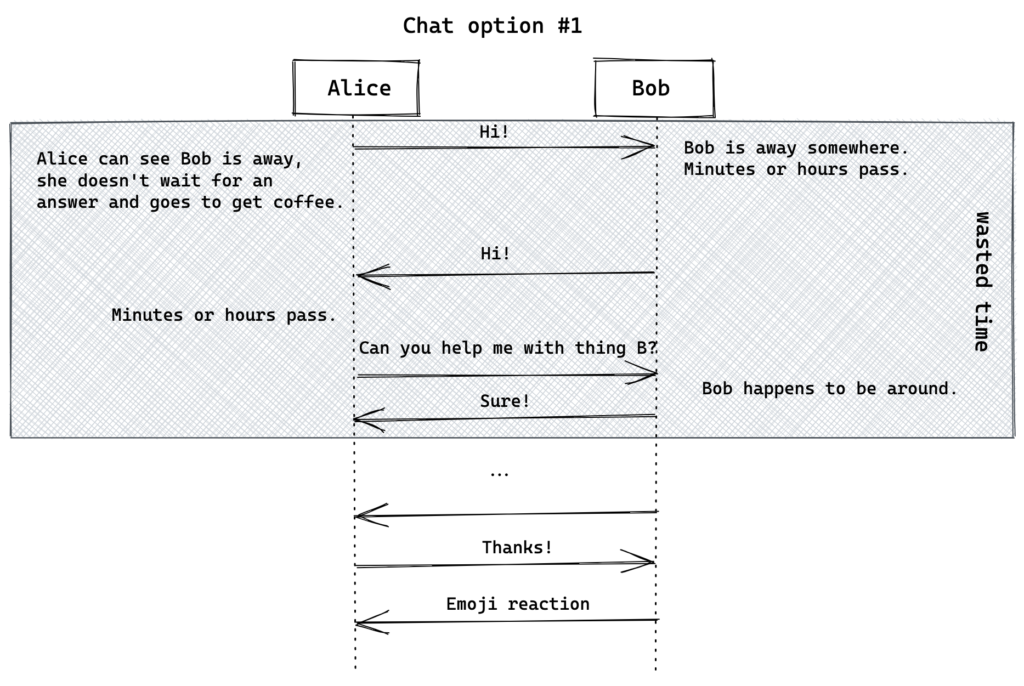
In the first scenario, Alice sends a message to Bob. Bob is away from his desk and doesn’t see the message for a while. By the time Bob responds, Alice is also gone. Two messages have been sent but no useful information has been passed between Alice and Bob. Only the 3rd message, delayed by who knows how long, is actually useful.
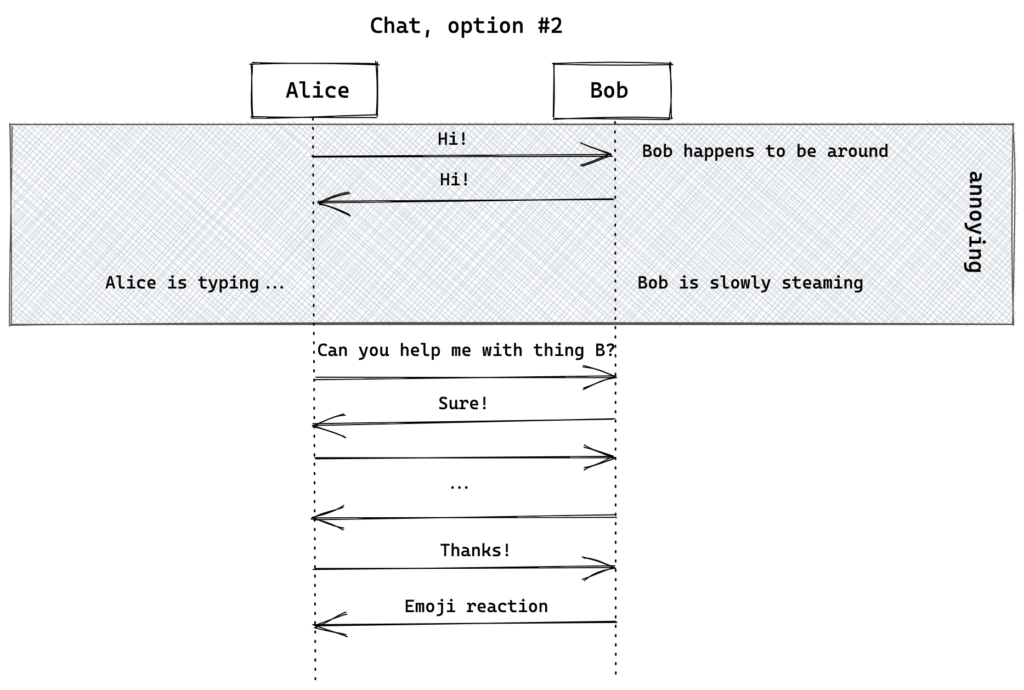
In the second scenario poor Bob happens to be available when Alice sends him that first message. He responds promptly only to wait while Alice types her message (and deletes and rephrases etc.). Again, only the 3rd message was useful, but we get the added bonus of letting Bob stare at “Alice is typing…” for a couple of minutes.
#nohello
This common interaction has birthed the unfortunately named #nohello movement, which begs you to just ask the question and not just Hello (also called naked ping).
nohello.net explains it best, I suggest you head on over there if you're not already familiar with the concept.
I say #nohello is unfortunately named because the name implies that you shouldn’t start with any greeting, which feels impersonal and not particularly nice. However, even when #nohello advocates explain that you can and should start with a polite greeting, some people insist that getting down to business without waiting for the mutual exchange of hello first is impolite at best, or at worst an indication of the imminent collapse of human society.
It might be interesting to note that it's never the people on the receiving end of a greeting + context message who are complaining about the sender being impolite - it's always the senders. Just saying.
To be honest, I understand why people wouldn’t think of #nohello on their own, but for a few years now I’ve been wondering why people who are exposed to the concept keep sending naked pings while maintaining that is the superior approach. I think I’ve finally figured it out:
Chat is a hybrid communication medium with both a synchronous mode and an asynchronous mode. This duality is causing people to apply the wrong communication protocol.
100% synchronous mode
Let’s look at a 100% synchronous conversation – face to face or a phone call. A normal face to face interaction starts with a mutual greeting. At this point a “session” is established, it would be really weird to suddenly walk away. Now there might be a polite exchange where Alice might not necessarily be interested in what’s actually going on with Bob, but protocol demands it – that’s just how polite conversations go. Now Alice can get to the point and ask Bob for what she actually needs from him. Ending conversations is an art in itself, but once Alice and Bob have determined the conversation is over there will be an exchange of bye-byes and both parties will walk away feeling just fine.
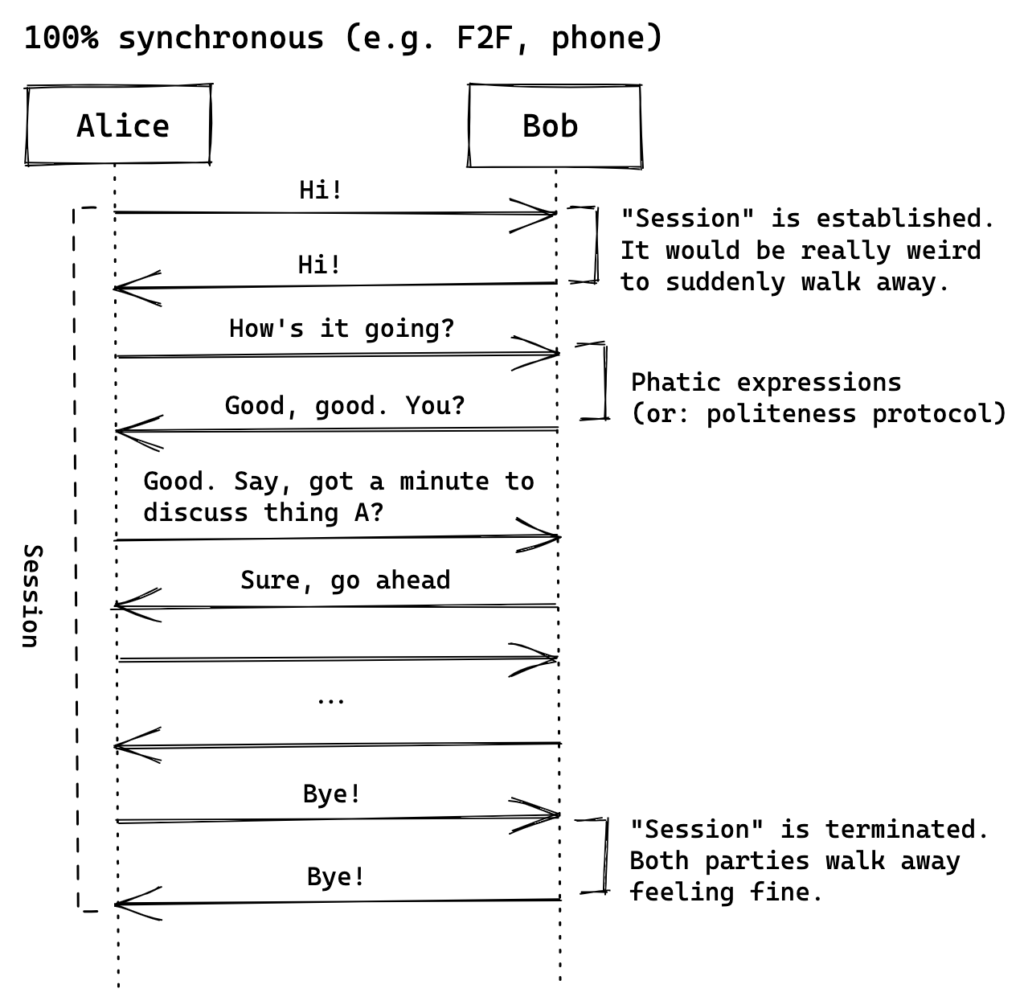
100% asynchronous
Another commonly used form of communication is email (or real mail, with a stamp and envelope). This type of conversation is 100% asynchronous – so while some people might expect a relatively fast answer, they don’t expect it to be instantaneous. In this mode of communication there is no “session” established at any point, and the way the message is written reflects that: It starts with a greeting, moves on to the content, and ends with a signature, signing off on the entire message.
Responses may be a bit less formal, but they will follow the same general structure – greeting, content, signature, all in the same message. No one feels that this is impolite.
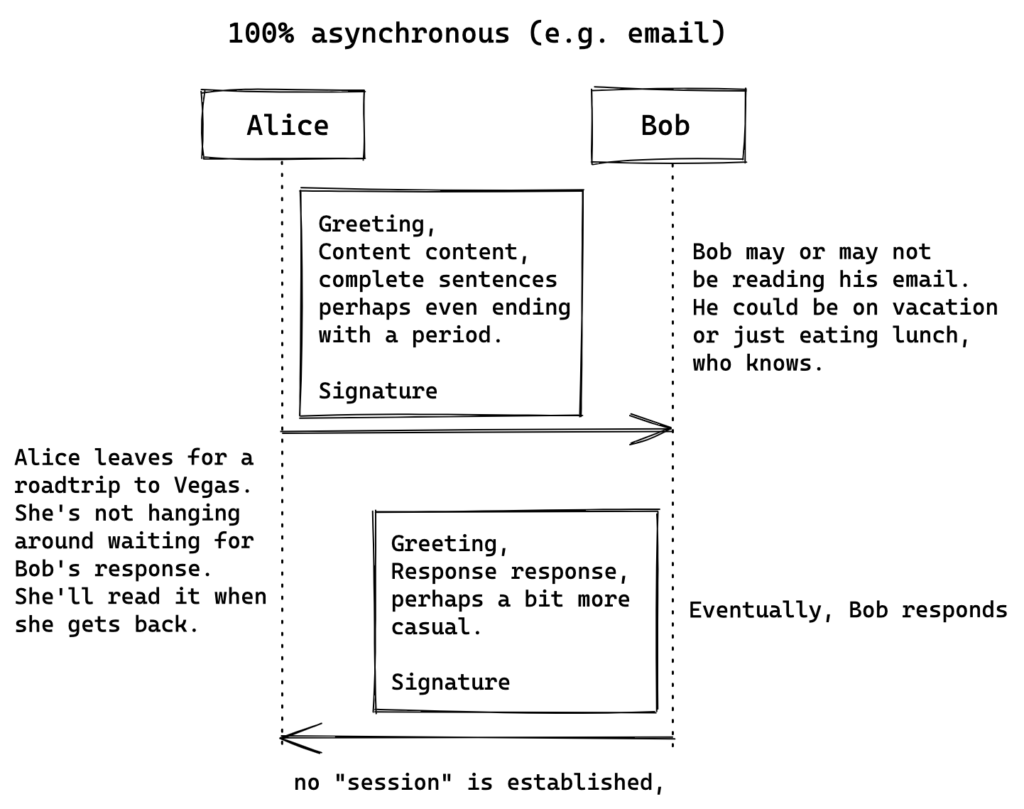
Async-sync hybrid
Now, let’s revisit what happens when we use chat at work. Alice wants to be nice, so she is applying the 100% synchronous protocol to her chat conversation with Bob, and is waiting for him to respond to her greeting before getting to the point.
As we can see in the image below – if Bob is away, the first part of the conversation is asynchronous. It doesn’t make sense to greet someone who isn’t there and then wait for an answer before proceeding.
By the time both Alice and Bob are around and available for a synchronous conversation – the “polite” part of the conversation has been entirely forgotten. Even if we didn’t care about wasting valuable time, the value of this kind of human interaction is questionable.
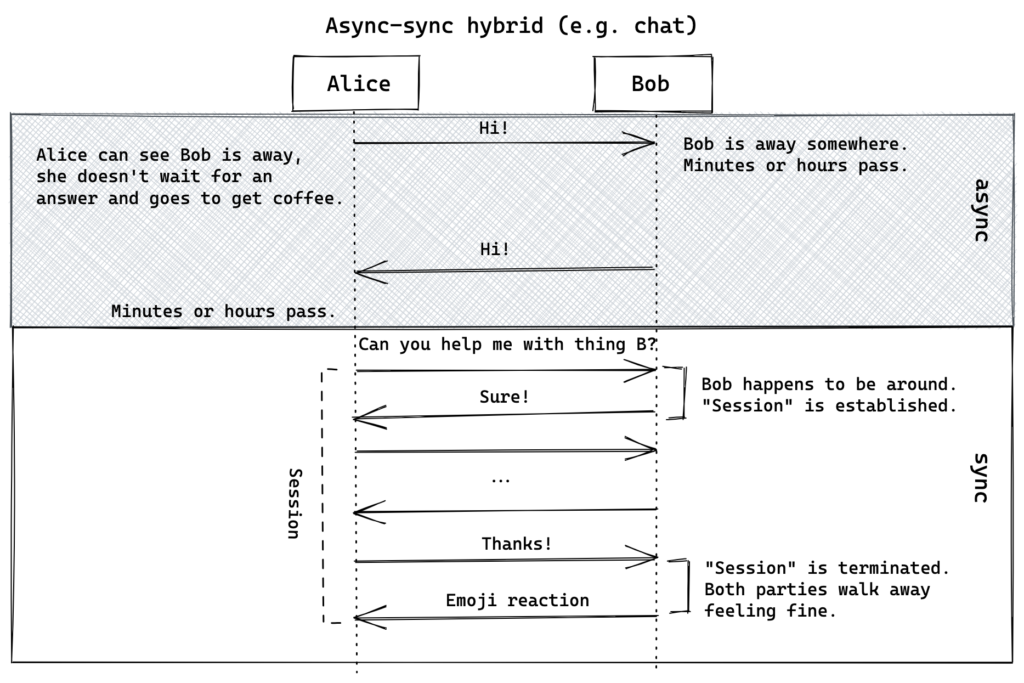
In the case where Bob happens to be around when Alice sends him that first hi and responds immediately, he still has to wait for Alice to finish typing whatever it is she actually wanted. Besides typing being much slower than speaking, it includes an inherent (asynchronous) delay – Alice won’t send the message until she’s done. So, while she’s applying the 100% synchronous conversation protocol – she’s actually leaving Bob to wait for many eternal seconds with nothing to do. Imagine if you called someone on the phone and then stayed silent for 30 seconds while you thought about what you wanted to say. Interrupting someone just to make them wait would be considered pretty rude.
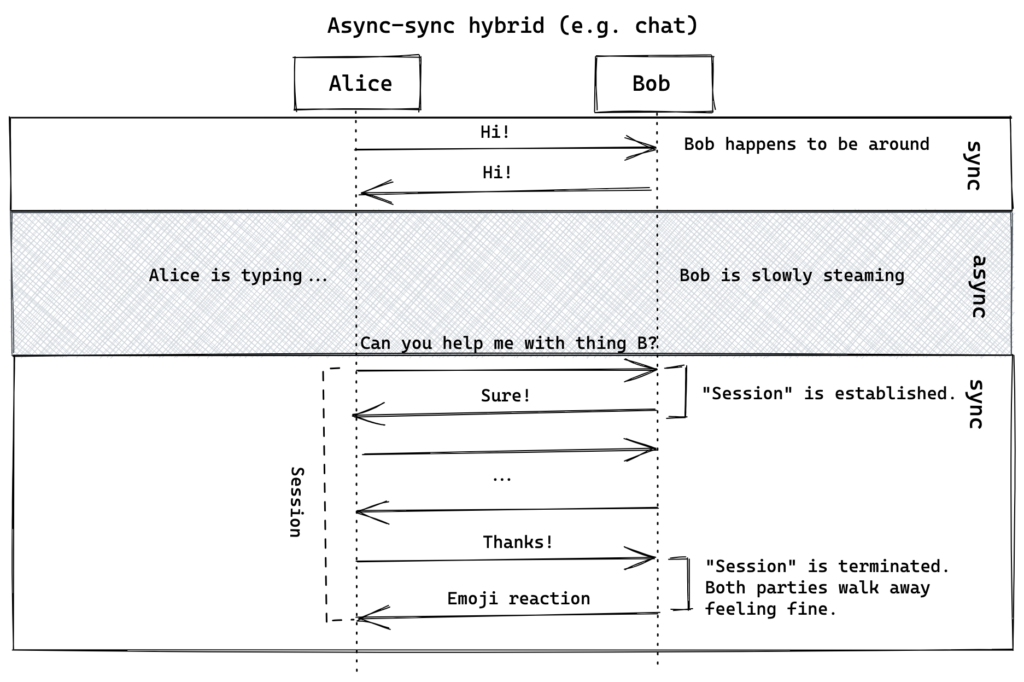
Why #nohello works
What #nohello does is apply the asynchronous conversation protocol while the conversation is asynchronous. Note that it’s not as asynchronous (nor as formal) as email – we don’t usually end a chat message with a signature – that would suggest we’re not expecting to establish a session at all.
Once a session is established (both Alice and Bob happen to be around), the conversation can switch to synchronous mode, with its own special social rules. Short messages, lots of emoji, an informal tone. A nice example of this type of “rule” is the emoji reaction – it enables Bob to signal to Alice that he’s seen her message and acknowledge it without interrupting her by calling her attention back to the conversation (imagine calling someone to say goodbye).
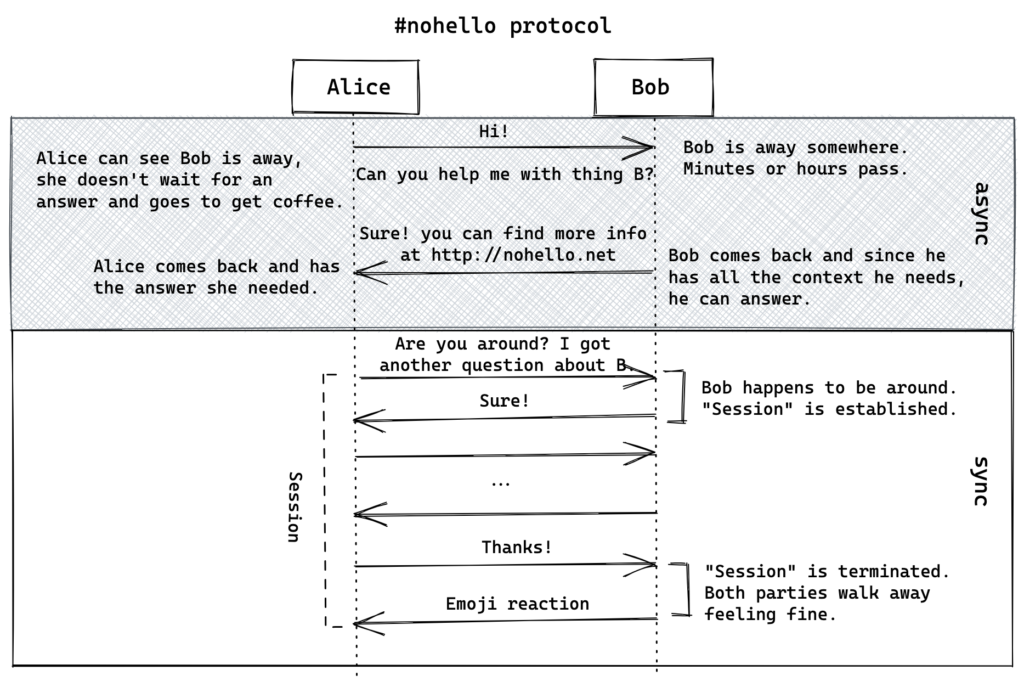
Personal interactions outside work are different - you assume that someone asking how you're doing actually cares to hear your answer, even if they're contacting you via text message. In this case, how close you are is all the context you need. Though, if you pay attention to how you feel when someone you're not particularly close to suddenly texts you - you're probably wondering why they're contacting you and waiting impatiently while they're typing and wishing they'd #nohello you next time. If you want to take #nohello to the next level with work-friends: When all you want is to say hello, be explicit about it. I will often message a work-friend to say good morning and include I don't need anything, just saying hi in the same message so they're not left with the burden of wondering if I'm waiting for them to respond before telling them what I want.
I hope I have you convinced that #nohello is the polite (and efficient!) way to communicate via chat in the workplace, or at least gave you some tools to convince others of the same. Thanks, bye!
